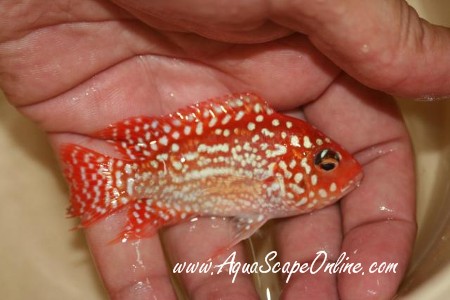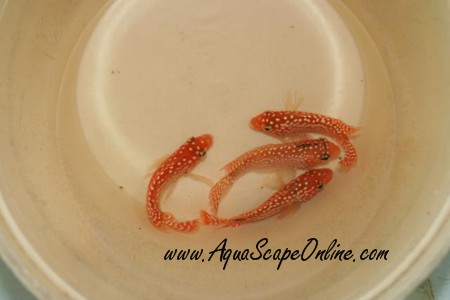 Red Texas - Belongs to the Golden base family of flowerhorns. To people and Thailand, Red texas are a completley different hybrid all together separate from Flowerhorns and are almost a different hobby in and of themselves. Originally created by breeding a Green Texas with a Mammon or KKP, then crossing back the offspring to the parents until a nice consistant red color is achieved. The most important feature of the Red Texas is quite obviously the color.
Red Texas - Belongs to the Golden base family of flowerhorns. To people and Thailand, Red texas are a completley different hybrid all together separate from Flowerhorns and are almost a different hobby in and of themselves. Originally created by breeding a Green Texas with a Mammon or KKP, then crossing back the offspring to the parents until a nice consistant red color is achieved. The most important feature of the Red Texas is quite obviously the color. Red Texas range in colors including:
- unfaded: lowes grade of RT
- yellow: second lowest grade
- Orange: majority of RT fall into this category
- Coral: pinkish but not quite full red
- Red: Most desirable color
The second characteristic that sets the Red Texas apart is the pearling. Red Texas can vary greatly in terms of type of pearling. There are three main types to consider when dealing with RT:
- Cyano or Dot pearls: These pearls come straight from one of the original 4 pure species cichlids used to create flowerhorn, Herichthys cyanoguttatus.
Examples of Dot pearls:
Resized to 94% (was 640 x 425) - Click image to enlarge
- Cyano or Dot pearls: These pearls come straight from one of the original 4 pure species cichlids used to create flowerhorn, Herichthys cyanoguttatus.
Examples of Dot pearls:
Resized to 94% (was 640 x 425) - Click image to enlarge

Resized to 94% (was 640 x 425) - Click image to enlarge

- Worm pearls: this is more of a desired trait in RT as well as Flowerhorns in general. RT with intense worm pearling are more costly and highly regarded than the Cyano or Dot pearling
Examples of worm pearling:
Resized to 94% (was 640 x 425) - Click image to enlarge

Resized to 94% (was 640 x 425) - Click image to enlarge

- Net pearls: The most desirable and most rare type of pearling. Very few fish display this type. Net pearling is almost a white framing of the individual scales themselves. When taken in from a distance it resembles a white mesh net.
Example of Net pearling
Resized to 94% (was 640 x 425) - Click image to enlarge

After coloring and pearls a red texas should then conform to normal flowerhorn standards (IE Large wide body, nice big tail, Large head, etc). Since the Herichthys species is not well known for their large nuchal humps, Red texas with heads are considered more difficult to come by.


Important:Don't be fooled by other sites claiming they have red Texas and when you get them they have no red color on them. Ours look just like the picture. True Red texas are already red/orange when they are born and not black like other sites claim.

This new species is finally back in stock. They Like a ph of 7.0 and a temperature of 78. They are very hardy and do well with other semi-aggressive fish. Males become aggressive and show a deeper red than females. I don't have many and I don't know when I will get more. I have been waiting almost a year to get this batch in. This is truly a nice colorful species to own.
